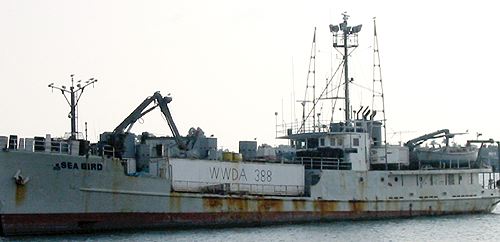
The new "World Digital Awareness" ship
Ranny's contact states, "We
really felt an affinity with the original Radio London in the UK - the 60s music
and the jingles. We want to bring back the "British Invasion" in radio
terms at least! Sadly though, we couldn't just choose a station name, what with
all the regulations and whatever over here. We wanted to use "Wonderful
Radio London" but the FCC (Federal Communicator Committee) wouldn't let
us use WRL as you now aren't allowed to use just three-letter callsigns any
more. This really isn't fair as couple years ago after being forced to use KKHJ,
station KHJ were allowed to go back to using their three-letter callsign. As
we would have had to add a 'W' to make it WWRL, we still weren't allowed to
use it, as there used to be a station by that name years ago, in LA."
After Radio London's further investigation, it transpires that the quote came
from Robert E Lee, Station
Manager and ex-Programme Director at WLBH, on the outskirts of LA. He was suspended
for a while when he failed to pay some of the DJs. "At the time we were
doing some special programmes for a US Navy charity, NRIL, (Naval Reserve Instructors
League). I didn't know the DJs expected to be paid! However, now we have a ship
that can be made ocean-going in about a couple months or so, therefore we can
go anywhere in America with our broadcasts – well, except on land!
"Although one of the big satellite radio stations here is interested in
taking us, and I can't say whether it's XM or Sirius at this stage, there is
no point in going on air if people can't hear you in the car and anywhere in
the home. With the prospect that the listener can now buy a satellite receiver
that will get us in the car, we're also excited about the prospect of going
on satellite because people can still hear us also anywhere in their house if
they turn the volume up loud enough. At this time of year it's not too hot or
cold in most of the US, so we are hoping that car users will have their windows
down, so attracting other road users to our station. While it is true that more
new cars in the US are being fitted with satellite radio, and as I said, you
can receive the stations also with a home satellite hi-fi unit, we feel that
AM still has a long way to go. This is definitely where the ship comes in. We
are going to take the ship around the US coast so that people can get a flavour
of what we have to offer.
"Because of the importance of the station in renewing interest in 60s music,
the FCC have allowed us 500kW in certain parts of the US on AM from the ship,
but that would be a dangerous undertaking, and rather hazardous for the crew
and DJs because of the close proximity to the antenna being on the ship and
all. Although there is new antenna technology available that could possibly
do this from a ship, we reckon we'll fall back to using 50kW to 150kW with a
conventional antenna to be on the safe side.
"As the FCC wouldn't allow us to use WWRL, we decided on a station name
of WWDA as that represents the main thrust really of what we're about –
the WDA part means "World Digital Awareness". The way forward is digital,
even on AM (and you only have to look on the internet to find out the details
of, for instance the DRM system). Heck even the British BBC are interested in
this technology for their World Service, so that must say something! We'll be
adding digital real soon, and that will give us a big boost in listeners!"
Ranny then asked Robert about the picture he'd provided of the ship at the centre
of the project. "The Sea Bird is able to travel under her own power and
what rust there is can be simply sorted out. Heck, it helps in providing good
contact with the sea as a good earth for the transmitter's antenna!" he
said.
But what about the "388" painted on the side? Apparently the FCC has
already given the company a little-used frequency of 770kHz throughout the US.
Robert says, "They have kindly given us that frequency and as a definite
tribute to Radio London in the UK, we felt that the frequency should be in wavelength
terms, so we've had lots of jingles prepared to include this. The frequency
is clear in many places on the US coast. We have to use low power in some locations
for the month or so that we'll be there, about 1kW, but some other places we'll
be up to at least 100kW. It's great to be able to use the same frequency on
all our promotional material wherever we are!"

The new
"World Digital Awareness" ship
Radio
London will bring you more news about this project when we have it.